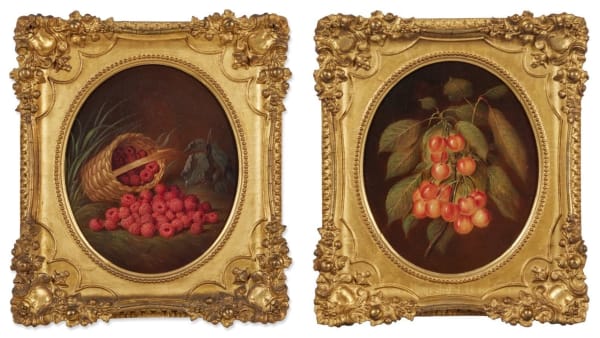Works
Biography
One of the many artist descendants of Charles Willson Peale, Sarah Peale was born in Philadelphia and became America's first professional female artist and a leading portrait painter of her day. She also did still lifes. Her art career lasted nearly sixty years, and she supported herself financially and successfully competed with male painters of that time including John Wesley Jarvis, Thomas Sully, and Jacob Eichholtz.
Her father was James Peale, a brother of Charles Willson, and her family called her Sally. She took early art training from her uncle, Charles Willson Peale, in his studio in Washington D.C., and he, unlike her father, was a believer in the equality of women and encouraged her to pursue her talent.
He led her to many good contacts by taking her to numerous social events in Washington D.C., where she charmed many people in society, which, in turn, secured her important commissions. She was also a close friend of Thomas Sully, another prominent portrait painter, and he took Sarah and his own daughters to lectures on anatomy, a subject closed to women of that era because of the indelicacy of the subject.
Her first large painting, a self portrait, was completed in 1818. From 1816 to 1831, she worked between Philadelphia and Baltimore, and then in 1825 moved to Baltimore where she worked in the Peale Museum run by her cousin Rembrandt. She became the most sought after portraitist of Baltimore, painting more than one-hundred of its leading citizens in a style that was regarded as skillfully realistic. Her subjects looked dignified, pleasant, and capable and had expressions that conveyed the idea they were genuinely human. Her early work had more decorative touches than her later pieces.
Although most commissions were from people who sought her, she also solicited commissions such as that of the Marquis de Lafayette, the French Ambassador, whom she contacted to pose for her when he came to Washington. He agreed and sat four times, but unfortunately the work is lost. Other politician subjects include Senator Thomas Hart Benton, Caleb Cushing and Daniel Webster.
In 1824, Sarah Peale became the first woman elected an Academician of the New York National Academy, which was in those days was the stamp of an artist's authenticity of meeting certain prescribed standards. Her sister, Anna Claypoole Peale, was also among the first female Academy members.
In 1845, because of ill health, she moved to St. Louis, Missouri at the invitation of its United States Senator, Trusten Polk. She liked the city and stayed for 32 years, becoming that city's leading portrait painter. Towards the end of her life, she took an increasing interest in still-life painting and won many prizes at the St. Louis fairs and other exhibitions. Reflecting the changing, loosening of styles, her still lifes, often with fruit, are much more freely painted than her early work. In 1878, she returned to Philadelphia, where she, never married, lived until her death in 1885 with two older widowed sisters.
Her father was James Peale, a brother of Charles Willson, and her family called her Sally. She took early art training from her uncle, Charles Willson Peale, in his studio in Washington D.C., and he, unlike her father, was a believer in the equality of women and encouraged her to pursue her talent.
He led her to many good contacts by taking her to numerous social events in Washington D.C., where she charmed many people in society, which, in turn, secured her important commissions. She was also a close friend of Thomas Sully, another prominent portrait painter, and he took Sarah and his own daughters to lectures on anatomy, a subject closed to women of that era because of the indelicacy of the subject.
Her first large painting, a self portrait, was completed in 1818. From 1816 to 1831, she worked between Philadelphia and Baltimore, and then in 1825 moved to Baltimore where she worked in the Peale Museum run by her cousin Rembrandt. She became the most sought after portraitist of Baltimore, painting more than one-hundred of its leading citizens in a style that was regarded as skillfully realistic. Her subjects looked dignified, pleasant, and capable and had expressions that conveyed the idea they were genuinely human. Her early work had more decorative touches than her later pieces.
Although most commissions were from people who sought her, she also solicited commissions such as that of the Marquis de Lafayette, the French Ambassador, whom she contacted to pose for her when he came to Washington. He agreed and sat four times, but unfortunately the work is lost. Other politician subjects include Senator Thomas Hart Benton, Caleb Cushing and Daniel Webster.
In 1824, Sarah Peale became the first woman elected an Academician of the New York National Academy, which was in those days was the stamp of an artist's authenticity of meeting certain prescribed standards. Her sister, Anna Claypoole Peale, was also among the first female Academy members.
In 1845, because of ill health, she moved to St. Louis, Missouri at the invitation of its United States Senator, Trusten Polk. She liked the city and stayed for 32 years, becoming that city's leading portrait painter. Towards the end of her life, she took an increasing interest in still-life painting and won many prizes at the St. Louis fairs and other exhibitions. Reflecting the changing, loosening of styles, her still lifes, often with fruit, are much more freely painted than her early work. In 1878, she returned to Philadelphia, where she, never married, lived until her death in 1885 with two older widowed sisters.
Press
Enquire



